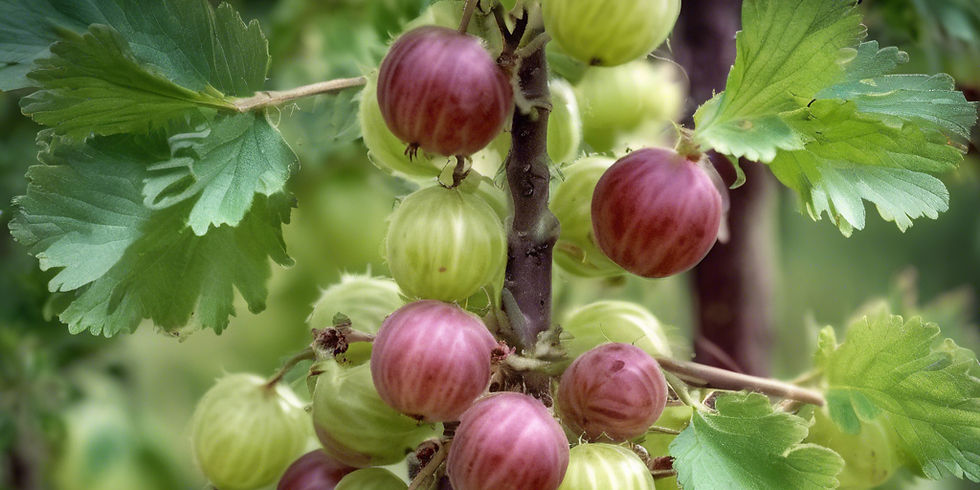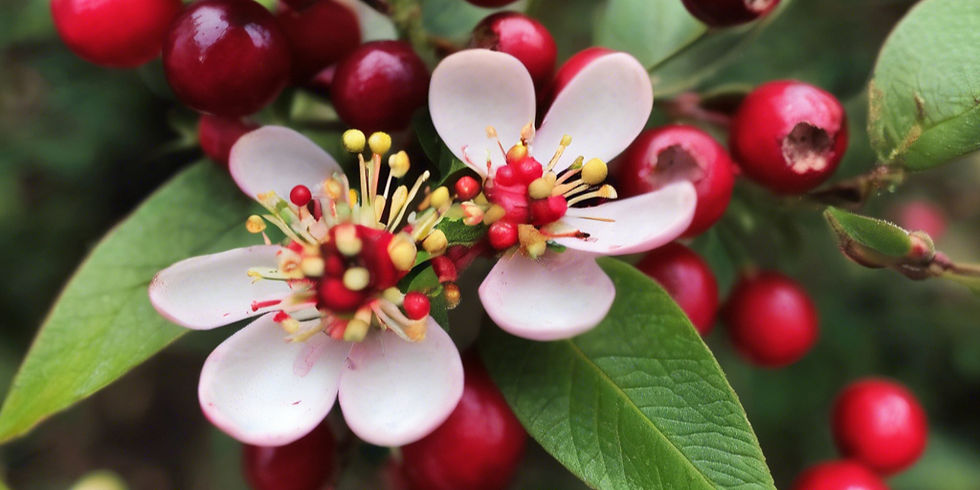Buffaloberry
- The Economic Botanist

- Mar 28
- 8 min read
Scientific Name: Shepherdia argentea (Pursh) Nutt.
Family: Elaeagnaceae

The buffaloberry is a hardy shrub native to North America, prized for its nutrient-rich red or yellowish berries. With a history deeply rooted in indigenous traditions, buffaloberry offers a range of culinary and medicinal benefits that have been utilized for centuries. This shrub is particularly well-suited to harsh environments, thriving in the arid regions of the western United States and Canada. Buffaloberry is not only valued for its resilience but also for its exceptional health benefits and versatile culinary uses, making it a unique addition to both traditional and modern diets.
In this article, we will explore the history, botanical characteristics, growing instructions, and comprehensive health benefits of buffaloberry. Additionally, we’ll delve into its various culinary applications, from fresh consumption to the creation of jams, sauces, and traditional dishes.
History of Buffaloberry
The buffaloberry has a long history of use by indigenous peoples in North America, particularly the Native American tribes of the Great Plains and the Rocky Mountains. The plant was valued for its edible berries, which were used both fresh and dried for various purposes. Indigenous peoples would often dry the berries for preservation, using them in winter months for sustenance, or mix them with animal fat to create high-energy food sources for hunting trips.
The name "buffaloberry" comes from the fact that the shrub was often found in areas frequented by bison, which would graze on the shrubs' leaves and berries. In fact, early settlers often noticed the presence of buffaloberries in the same regions where large herds of bison were common. Native Americans also used parts of the plant, including the bark and roots, for medicinal purposes.
European settlers, upon discovering the plant, quickly realized the nutritional and medicinal potential of the berries, though it wasn’t until much later that buffaloberry’s health benefits began to gain recognition in Western culture. Today, buffaloberry is still cultivated for its nutritious fruit, which is consumed both in raw and processed forms.
Botanical Description
The buffaloberry shrub (Shepherdia argentea) is a deciduous, multi-stemmed plant that grows between 3 to 6 feet (1 to 2 meters) in height. It is often found in natural environments such as grasslands, forests, and open woodlands, particularly in dry, well-drained soils. Buffaloberry thrives in harsh conditions, including areas with high winds and poor soil quality, making it an ideal plant for xeriscaping (landscaping with drought-tolerant plants).
Buffaloberry plants have silvery-gray branches, which give the plant its distinctive appearance. The branches are often covered with fine, silvery hairs that reflect sunlight, helping the plant conserve water. The leaves are small, elliptical, and covered in silvery scales on both sides, giving them a unique sheen. The shrub’s flowers are small, yellowish, and fragrant, and they bloom in late spring to early summer.
The berries of the buffaloberry are small, round, and typically range in color from bright red to orange or yellow. The fruit is borne in dense clusters and has a bitter, tart flavor that makes it unsuitable for fresh consumption in large quantities. However, when processed, the berries are incredibly versatile and can be used to create jams, jellies, sauces, and beverages. The skin of the berries is thin, and the interior contains a seed surrounded by a fleshy pulp.

Growing Instructions
Buffaloberry is an adaptable plant that thrives in tough environmental conditions, making it an excellent choice for gardeners looking for a resilient and low-maintenance fruit shrub. Here’s a step-by-step guide to growing buffaloberry:
Sunlight: Buffaloberry prefers full sunlight but can tolerate partial shade, especially in areas with hot summers. Full sunlight will help the plant grow vigorously and produce abundant fruit. Ideally, it should receive at least 6 hours of direct sunlight per day.
Soil: Buffaloberry grows best in well-drained, sandy or loamy soils. It is highly tolerant of dry, alkaline, and saline soils and can even thrive in nutrient-poor conditions, making it suitable for areas with poor soil quality. However, for optimal growth and fruiting, a moderately rich, slightly acidic to neutral soil pH of 6.0 to 7.5 is ideal.
Temperature: Buffaloberry is a cold-hardy shrub and can withstand temperatures as low as -40°F (-40°C) once established. It thrives in regions with cold winters and warm summers, making it a perfect choice for colder climates or high-altitude areas. The plant is well-suited for USDA hardiness zones 2 through 7.
Watering: While buffaloberry is drought-tolerant once established, it benefits from consistent watering during its first few years of growth. Water the plant deeply, especially during dry periods, but avoid waterlogging, as this can cause root rot. Once established, the plant can survive with minimal irrigation.
Spacing: Buffaloberry shrubs should be spaced about 3 to 5 feet (1 to 1.5 meters) apart to allow for proper air circulation and room to grow. Planting too close together can lead to overcrowding, which may increase the risk of disease and hinder fruit production.
Pruning: Pruning is generally not necessary for buffaloberry plants, but occasional maintenance can help maintain a tidy shape and encourage healthy growth. Prune in early spring, removing any dead, damaged, or diseased branches. If the shrub becomes too large, thinning out the older wood will promote new growth.
Support: Buffaloberry is a relatively low-maintenance shrub that does not require additional support. However, in particularly windy areas, staking may be necessary to prevent the plant from leaning or breaking under the weight of its berries.
Life Cycle: Buffaloberry follows a typical perennial life cycle, meaning it will continue to grow year after year once established. The life cycle consists of several stages, from germination to fruiting.
Germination: Buffaloberry is usually propagated by seeds or cuttings. Seeds should be stratified (subjected to a period of cold) before planting to ensure successful germination. Alternatively, cuttings from healthy shrubs can be rooted in water or soil to establish new plants.
Vegetative Growth: In the early years, buffaloberry plants focus on developing their root systems and producing foliage. They grow vigorously during spring and summer, developing their distinctive silver leaves and silvery branches. The plant will begin producing flowers in the second or third year.
Flowering: Buffaloberry flowers bloom in late spring to early summer. The small, yellowish flowers are clustered together and are pollinated by wind or insects. Flowering typically lasts for several weeks.
Fruit Set: Following pollination, buffaloberry plants begin to produce small, tart fruits. The berries grow in clusters and ripen by late summer to early fall. Depending on the climate and variety, fruiting may continue for several weeks.
End of Season: After the fruit has been harvested, buffaloberry plants enter dormancy for the winter months. The leaves will fall, and the plant will conserve energy until the warmer months return, at which point the cycle starts again.
Harvesting and Foraging
Harvesting: Buffaloberry fruits are typically ready to harvest in late summer to early fall when they have fully ripened and the berries have reached their optimal color. The berries can be harvested by hand or using a small rake or comb to gently pull the berries from the shrub. Keep in mind that the berries are quite tart, so they are usually processed into jams, jellies, or sauces rather than eaten fresh.
Foraging: Buffaloberry shrubs can be found in the wild across North America, particularly in the western United States and Canada. When foraging for buffaloberries, it’s important to ensure that you are properly identifying the plant, as its berries may be mistaken for other wild fruits. Always forage responsibly by only picking from abundant plants and leaving some fruit for wildlife.
Plant Companions
Buffaloberry plants are relatively independent and do not require specific companion plants to thrive. However, they can benefit from being planted alongside other drought-tolerant, hardy shrubs, such as sagebrush, junipers, or certain varieties of native grasses. These companions can help attract pollinators, such as bees and butterflies, which are essential for the plant's flowering and fruiting process.
Common Pests and Diseases
Pests:
Aphids: Aphids may occasionally infest buffaloberry plants, feeding on the leaves and stems. Control aphids by spraying the plant with a mild insecticidal soap or introducing natural predators like ladybugs.
Spider Mites: Spider mites can cause damage to the foliage by feeding on plant sap. Regular watering and spraying the leaves with water can help deter these pests.
Diseases:
Powdery Mildew: Powdery mildew may appear on the leaves, causing a white, powdery substance to form on the surface. Prevent mildew by spacing plants properly and ensuring good airflow.
Rust: Buffaloberry is susceptible to rust fungus, which causes orange or red spots on the leaves. Fungicidal treatments or removal of infected leaves can help control this disease.
Shopping Tips
When purchasing buffaloberries, look for fresh, ripe fruit that is firm and vibrant in color. Dried buffaloberries can also be found at specialty stores or online. Ensure that the berries have been properly dried and stored to preserve their nutritional content.
Storage
Fresh buffaloberries should be consumed within a few days after harvesting. If you’re not planning to use them immediately, store them in the refrigerator. For longer-term storage, buffaloberries can be dried, frozen, or processed into jams or sauces. Dried berries can be stored in an airtight container for several months in a cool, dark place.
Food Safety
As with any wild berry, buffaloberries should be harvested from clean areas free of pesticides, chemicals, and animal waste to avoid contamination. Washing the berries thoroughly before consuming or processing them is important to minimize this risk.
Culinary Uses
Buffaloberries have a unique, tart flavor that lends themselves well to a variety of culinary applications, especially when cooked or processed. Below are some popular ways to enjoy buffaloberries:
Jams and Jellies: Buffaloberries are often used to make sweet and tart jams, jellies, and preserves. Their high pectin content makes them ideal for creating firm spreads.
Sauces and Syrups: The tartness of buffaloberries makes them an excellent base for savory sauces or sweet syrups, often used to accompany meats like venison, poultry, or pork.
Beverages: Buffaloberries can be used to make refreshing juices or added to homemade wine, adding a unique flavor profile.
Baked Goods: The berries can be incorporated into pies, muffins, or cakes, offering a tart contrast to sweet ingredients.

Health Benefits
Buffaloberries are rich in nutrients, antioxidants, and essential vitamins, making them a valuable addition to any diet. The key health benefits of buffaloberries include:
High in Vitamin C: Buffaloberries are an excellent source of vitamin C, which is vital for immune function, collagen synthesis, and skin health.
Rich in Antioxidants: Buffaloberries contain antioxidants such as flavonoids, which protect the body from oxidative stress and may reduce the risk of chronic diseases.
Anti-Inflammatory Properties: The compounds found in buffaloberries may help reduce inflammation, promoting joint health and alleviating symptoms of conditions like arthritis.
Supports Digestion: Buffaloberries are a good source of dietary fiber, which aids digestion, promotes gut health, and helps prevent constipation.
Toxicity and Safety
Buffaloberries contain saponins, which are naturally occurring compounds that can be toxic in high amounts. Eating the berries raw in large quantities may cause digestive upset or other symptoms, such as nausea or vomiting. However, the berries can be safely consumed after being processed (e.g., cooked or dried), as cooking or drying helps reduce the saponin content.
The berries are typically more palatable when fully ripe, which is usually in late summer or early fall.
Environmental Impact
Buffaloberry plants are highly drought-tolerant and can thrive in poor soil conditions, making them a sustainable choice for gardeners and landowners looking to conserve water and reduce their environmental impact. These plants provide valuable habitat and food for wildlife, including birds and small mammals.




Comments